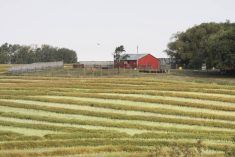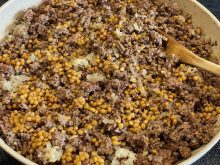In 1899, about 300 Russian Doukhobors fled their homeland in Russia and settled in the Blaine Lake area of Saskatchewan. Part of their survival tactic was to dig into the North Saskatchewan River ravine to build dugout houses, similar in style to the houses of Caucasus. The dwellings were part cave, part log structure.
Many lived there for five years while the village of Oospenie was being built nearby.
Brenda Cheveldayoff’s great-grandfather, Iakov Fedor Popoff, was an 11-year old orphan who lived with 40 others in a 436 sq. foot dugout house built the year the Doukhobors arrived in Canada. The land on which the dugout was built became the Popoff homestead in 1925. When Brenda’s father Sam took over the farm, he valued the weathered remains of the original ravine house and passed on all of his stories to her.
Read Also

Nutritious pork packed with vitamins, essential minerals
Recipes for pork
It is in her father’s memory that Brenda has undertaken the work of having the Doukhobor dugout house restored and opened to the public as a historical site. The site has also been the basis of an archeological study led by
Meagan Brook.
The work at the site is the subject of Brook’s master’s thesis, Public Archaeology With a Doukhobor Descendant Community. Copies of the thesis have been given to other Canadian communities of Doukhobor descent, as well as the Saskatchewan Archives Board and Saskatoon Public Library.
A group of Doukhobor community volunteers worked with Brook to investigate and preserve the history at the site. The volunteers gained an understanding and an appreciation for the hardships, struggles, determination and resilience of the early community.
They realized that every artifact they found in the house had significance – an oven door, a button, pottery, an old shoe. These were all poignant memories of what life was like during those early years, 1899-1904.
With no money and few resources to survive, the men went to work on the railroads in the summer months and the women hitched themselves to the plows to turn over land for gardens.
As vegetarians, their basic foods were bread, vegetables and fruit. Large brick ovens were built for bread baking and a flour mill and jam factory were soon added.
In 2005, the Doukhobor dugout house cave site received provincial heritage designation and is now open to the public Saturdays May 20 to Aug. 26. School and group tours are also available. For more information, go to
www.doukhobor
dugouthouse.com.
It is interesting that in 1996, just after we started writing this column, we received a request for a Doukhobor bread recipe. My sister-in-law’s sister, Delva Reben’s husband, Norm, has a Doukhobor heritage. They shared Norm’s mother’s bread recipe, which we printed in our column. Now 10 years later this recipe is highlighted at the Doukhobor Dugout House site.
The following is Anne Reben’s traditional bread recipe.
Doukhobor bread
1/2 cup warm water 125 mL
2 tablespoons sugar 30 mL
1 package or 21/2 12 mL
teaspoons traditional yeast
5 cups lukewarm water 1.25 L
14 cups flour 3.5 L
1 heaping tablespoon salt 15 mL
1/3 cup melted butter or 75 mL
shortening
Into the 1/2 cup (125 mL) of warm water add the sugar and yeast. Set in a warm place to rise until the cup is full. Place the five cups (1.25 L) of lukewarm water in a large bowl; add the salt and the raised yeast and half of the melted butter or shortening. Add sifted flour a little at a time and mix by hand. Knead until it does not stick to the hands.
When all of the flour is used, scrape the sides of the container and butter them. Pour the remaining butter on your hands and knead the dough until it is elastic and shiny.
Cover the dough and put in a warm place to rise. When double in bulk, punch down, let it rise again and punch down and let it rise a third time to double in size. Then form into loaves and put into buttered loaf pans.
Punch the loaves with a fork in a few places to remove bubbles of air. Let them rise to double in size, and then bake for one hour at 350-400 F (180-200 C). If the crust is not a nice brown, increase heat the last 10 minutes.
Smaller version
I made this recipe again recently but reduced the size to make it in my Kitchen Aide mixer with the dough hook. The taste is the same but it is easier to make.
1/2 cup warm water 125 mL
1 tablespoon sugar 15 mL
1/2 package or 11/4 6 mL
teaspoons traditional yeast
21/2 cups lukewarm 625 mL
water
7 cups flour 1.75 L
1/2 heaping tablespoon 7.5 mL
salt
3 tablespoons melted 45 mL
butter or shortening
I followed the same method as given in the previous recipe except I used the dough hook to do the kneading.
From the Canadian Museum of Civilization website at www.civilization.ca I found this interesting comparison of Russian and Doukhobor borscht. Russian borscht is made with a meat-based stock and is true to its name, which means beetroot soup. It is usually beet-red in colour and is sometimes served cold, often with a dollop of sour cream. While each cook has a variation, Doukhobor borscht is vegetarian, made with tomatoes, cabbage, onions, potatoes, plenty of dill and one tiny token beet. It is orange in colour and is always served hot, usually without sour cream.
Sour cream substitute
Dear TEAM: I was wondering if there is anything I can use as a substitute for sour cream in casseroles and potato dishes especially. I really hate the taste of sour cream. I have tried using just milk but that doesn’t always work because the result is too runny. I recently acquired a potato cookbook and I’m enjoying it, but many of the recipes seem to need sour cream. – E.M., Kinley, Sask.
Dear E.M.: There are several things that you can substitute for sour cream. Cottage cheese is one. You may want to blend it smooth first so you have the same texture as sour cream. Another option is to use plain yogurt, especially in your potato recipes. Ricotta cheese is similar in taste to cottage cheese.
If the item you are making is sweet like a cheesecake, dessert or cake, you may be able to use cream cheese or a combination of cream cheese and whipped cream or cream cheese and Cool Whip.
Handy hints
n T.S., Buchanan, Sask., shared this travel hint. When you travel, keep a $20 bill in your sock in case your wallet is stolen or misplaced before you can get back to your hotel room. You can write the address of your hotel on the bill, too.
n If you have Corelle dishes that have turned yellow from iron in the water, here’s how to clean them. Fill a large pot 3/4 full of water. Add two to three cups (500Ð750 mL) of fresh or frozen cut rhubarb. Bring to a boil and cook three minutes. Cool to warm and dip in the dishes for about a minute and the stains are gone. J.Z., Shell Lake, Sask., said she has used this treatment to remove rust stains from dishes as well.
Bean salad
This recipe is great for picnics or potlucks.
1 can (19 oz.) mixed beans 540 mL
1 can (14 oz.) red kidney beans 398 mL
1 can (12 oz.) kernel corn 341 mL
3/4 cup diced celery 175 mL
1 mild onion or red onion, thinly
sliced, rings separated
1/2 cup white vinegar 125 mL
1/2 cup canola oil 125 mL
1/2 cup white sugar 125 mL
1 teaspoon celery salt 5 mL
1/4 teaspoon pepper 1 mL
1/2 teaspoon salt 2 mL
1/2 teaspoon dry mustard 2 mL
1/2 cup green or red pepper, 125 mL
chopped
1/2 cup fresh mushrooms, sliced 125 mL
Drain beans and rinse with water and drain again. Place beans in a bowl that has a sealable plastic lid. Drain the corn and add. Chop the celery and onions and add to the bean mixture. Place the vinegar and oil in a saucepan and heat. Add the sugar and stir until dissolved. Add the spices and mustard, stir to mix. Pour over the bean mixture.
Gently mix together. Cover and refrigerate for several hours or overnight. Over a sink, turn the container upside down to mix the dressing with the bean mixture. Do this once or twice during the marinating period.
Just before serving, add the chopped pepper and sliced mushrooms. This can be served from the bowl or else drain it and serve on individual plates on a lettuce leaf.
Variation: Canned or fresh yellow or green beans could be added instead of the corn.
Betty Ann Deobald is a home economist from Rosetown, Sask., and one of four columnists comprising Team Resources. Send correspondence in care of this newspaper, Box 2500, Saskatoon, Sask., S7K 2C4 or contact them at team@producer.com.
















